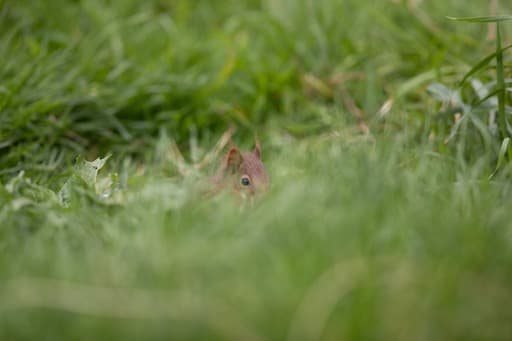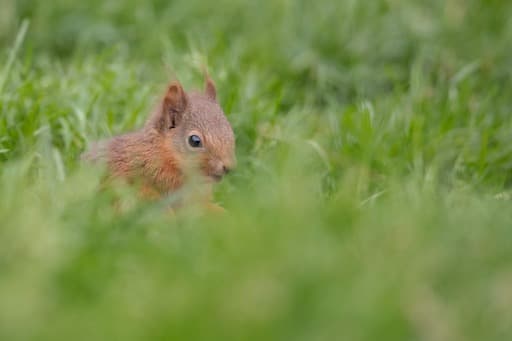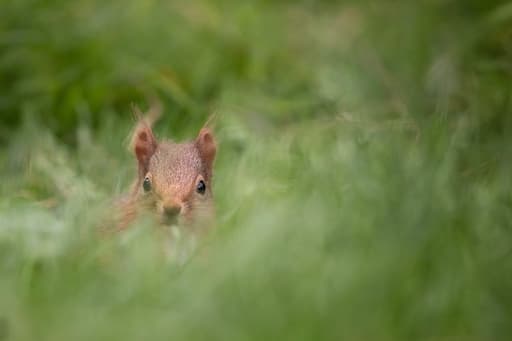Red Squirrels In Spring
Scottish Squirrels have absolutely brilliant information about red squirrels and their breeding. Read the "Saving Scotland Red Squirrels" web site Busy Breeding section to learn more.
Red squirrels are active all year round, and don't hibernate. If there are warm December or January days, Jock enjoys a stroll through the woods, taking great delight in watching the antics of the squirrels. He plays jumping games with them as red squirrels can jump up to 5m and from a standing position! Jock usually hears the red squirrels before he sees them, with scrabbling claws, chirruping and calling as they race around the tree trunks, leap through the branches and chase over the ground. Mating season has begun! The females are only fertile for one day in each cycle, and the males compete for the right to mate. They’re not involved in rearing the kittens.
The amount of food available, weather and body conditions all make a difference to successful breeding. Red squirrels feed on shoots and flowers in spring, and nuts, fruits and seeds from cones in autumn and winter. Females must be at least 280-300 g in weight to breed. If there is plenty food available, 2 litters of kittens (kits) may be born, in early spring, February/March, and in the summer, May/June. If the mum is in good condition, she may produce heavier kits, which will have a better chance of making it though their first year.
A squirrel’s nest is called a drey-they may use an average of 3 dreys. From the ground you may see an untidy football sized mass of twigs, close to the main trunk of the tree, supported by branches. This is the outer shell, but on the inside there is a lovely cosy lining made from mosses, lichens, leaves, conifer needles and grass, which the squirrel has collected.
The pregnancy will last 36-42 days, with 3/4 kittens the average sized litter. When born, these tiny kittens only weigh 10-18 g. They are deaf, blind and have no fur. The first hairs appear around 14 days, and they will have all their dark fur by 3 weeks. Around this time their first teeth come through, and their eyes and ears open when they are about 4 weeks old. The mum will suckle them for their first 50-70 days. She is very protective and will defend her young from predators like pine martens, foxes, wild and domestic cats, stoats, and birds of prey like goshawks and some types of owl.
The kits start coming out of the drey at around 6-7 weeks old, when they start taking their first solid food. By 10-12 weeks the kits have their first set of teeth and are weaned. The mum will defend them for another 2 weeks. She will be spending more and more time away from the kits.
Kits are darker than adults but they moult into their adult coats at around 4 months. Their permanent teeth come in when they are 4-8 months old. All Squirrels (rodents) have a pair of upper and a pair of lower teeth called incisors. Unlike our teeth, these incisors don't have roots, and they never stop growing! The squirrel's incisors grow at a rate of 15cm per year, but they stay short because of their continuous use and wear, particularly in opening pine cones and other seeds.
The litter tends to stay together and they will often stay in their breeding drey once their mother has moved out. Adults are most active during the beginning and end of the day. You might be lucky enough to see the kits playfully exploring when the adults are resting. They tend to stay close to their drey for much of the summer, but most will have gone off by autumn.
Sadly it’s thought that only 15-25% will get through their first winter, but those that do survive they may live for 3-4 years on average. The good news is that by 9-10 months old, providing they have had enough food and are in good body condition, they can breed in their first year.
Watch this wonderful video about orphaned red squirrel kits:
Scottish Squirrels have absolutely brilliant information about red squirrels and their breeding: Busy Breeding.
Interested in finding out more about red squirrels?
This is part of the Animals In Spring information.


